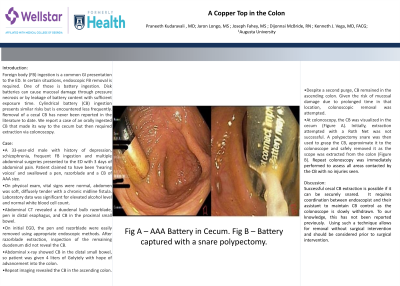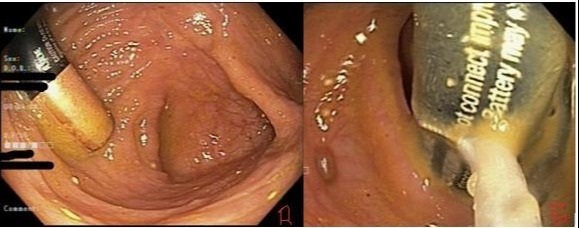Sunday Poster Session
Category: Colon
P0295 - A Copper Top in the Colon
Sunday, October 22, 2023
3:30 PM - 7:00 PM PT
Location: Exhibit Hall

Has Audio

Praneeth Kudaravalli, MD
Augusta University
Augusta, Georgia
Presenting Author(s)
Praneeth Kudaravalli, MD1, Jaron Lango, MS1, Joseph Fahey, MS1, Dijonnai McBride, RN1, Kenneth J. Vega, MD, FACG2
1Augusta University, Augusta, GA; 2Medical College of Georgia at Augusta University, Augusta, GA
Introduction: Foreign body (FB) ingestion is a common GI presentation to the ED. In certain situations, endoscopic FB removal is required. One of those is battery ingestion. Disk batteries can cause mucosal damage through pressure necrosis or by leakage of battery content with sufficient exposure time. Cylindrical battery (CB) ingestion presents similar risks but is encountered less. Removal of a cecal CB has never not been reported in the literature to date. We report a case of an orally ingested CB that made its way to the cecum but then required removal from there by colonoscopy.
Case Description/Methods: A 33-year-old male with history of depression, schizophrenia, frequent FB ingestion and multiple abdominal surgeries presented to the ED with 3 days of abdominal pain. Patient claimed to have been ‘hearing voices’ and swallowed a pen, razorblade and a CB of AAA size.
On physical exam, vital signs were normal, abdomen was soft, diffusely tender with a chronic midline fistula. Laboratory data was significant for elevated alcohol level and normal white blood cell count. Abdominal CT revealed a duodenal bulb razorblade, pen in distal esophagus, and CB in the proximal small bowel. On initial EGD, the pen and razorblade were easily removed using appropriate endoscopic methods. After razorblade extraction, inspection of the remaining duodenum did not reveal the CB. Abdominal x-ray showed CB in the distal small bowel, so patient was given 4 liters of Golytely with hope of advancement into the colon. Repeat imaging revealed the CB in the ascending colon. Despite a second purge, CB remained in the ascending colon. Given the risk of mucosal damage due to prolonged time in that location, colonoscopic removal was attempted. At colonoscopy, the CB was visualized in the cecum (Figure A). Initially, extraction attempted with a Roth Net was not successful. A polypectomy snare was then used to grasp the CB, approximate it to the colonoscope and safely removed it as the scope was extracted from the colon (Figure B). Repeat colonoscopy was immediately performed to assess all areas contacted by the CB with no injuries seen.
Discussion: Successful cecal CB extraction is possible if it can be securely snared. It requires coordination between endoscopist and their assistant to maintain CB control as the colonoscope is slowly withdrawn. To our knowledge, this has not been reported previously. Using such a technique allows for removal without surgical intervention and should be considered.

Disclosures:
Praneeth Kudaravalli, MD1, Jaron Lango, MS1, Joseph Fahey, MS1, Dijonnai McBride, RN1, Kenneth J. Vega, MD, FACG2. P0295 - A Copper Top in the Colon, ACG 2023 Annual Scientific Meeting Abstracts. Vancouver, BC, Canada: American College of Gastroenterology.
1Augusta University, Augusta, GA; 2Medical College of Georgia at Augusta University, Augusta, GA
Introduction: Foreign body (FB) ingestion is a common GI presentation to the ED. In certain situations, endoscopic FB removal is required. One of those is battery ingestion. Disk batteries can cause mucosal damage through pressure necrosis or by leakage of battery content with sufficient exposure time. Cylindrical battery (CB) ingestion presents similar risks but is encountered less. Removal of a cecal CB has never not been reported in the literature to date. We report a case of an orally ingested CB that made its way to the cecum but then required removal from there by colonoscopy.
Case Description/Methods: A 33-year-old male with history of depression, schizophrenia, frequent FB ingestion and multiple abdominal surgeries presented to the ED with 3 days of abdominal pain. Patient claimed to have been ‘hearing voices’ and swallowed a pen, razorblade and a CB of AAA size.
On physical exam, vital signs were normal, abdomen was soft, diffusely tender with a chronic midline fistula. Laboratory data was significant for elevated alcohol level and normal white blood cell count. Abdominal CT revealed a duodenal bulb razorblade, pen in distal esophagus, and CB in the proximal small bowel. On initial EGD, the pen and razorblade were easily removed using appropriate endoscopic methods. After razorblade extraction, inspection of the remaining duodenum did not reveal the CB. Abdominal x-ray showed CB in the distal small bowel, so patient was given 4 liters of Golytely with hope of advancement into the colon. Repeat imaging revealed the CB in the ascending colon. Despite a second purge, CB remained in the ascending colon. Given the risk of mucosal damage due to prolonged time in that location, colonoscopic removal was attempted. At colonoscopy, the CB was visualized in the cecum (Figure A). Initially, extraction attempted with a Roth Net was not successful. A polypectomy snare was then used to grasp the CB, approximate it to the colonoscope and safely removed it as the scope was extracted from the colon (Figure B). Repeat colonoscopy was immediately performed to assess all areas contacted by the CB with no injuries seen.
Discussion: Successful cecal CB extraction is possible if it can be securely snared. It requires coordination between endoscopist and their assistant to maintain CB control as the colonoscope is slowly withdrawn. To our knowledge, this has not been reported previously. Using such a technique allows for removal without surgical intervention and should be considered.

Figure: Fig A – AAA Battery in Cecum. Fig B – Battery captured with a snare polypectomy.
Disclosures:
Praneeth Kudaravalli indicated no relevant financial relationships.
Jaron Lango indicated no relevant financial relationships.
Joseph Fahey indicated no relevant financial relationships.
Dijonnai McBride indicated no relevant financial relationships.
Kenneth Vega indicated no relevant financial relationships.
Praneeth Kudaravalli, MD1, Jaron Lango, MS1, Joseph Fahey, MS1, Dijonnai McBride, RN1, Kenneth J. Vega, MD, FACG2. P0295 - A Copper Top in the Colon, ACG 2023 Annual Scientific Meeting Abstracts. Vancouver, BC, Canada: American College of Gastroenterology.
